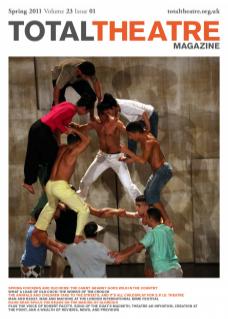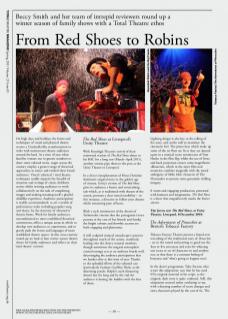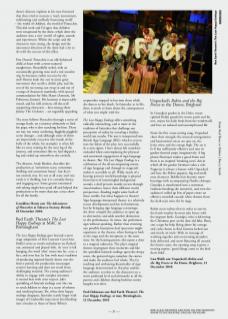On high days and holidays the forms and techniques of visual and physical theatre receive a Cinderella-like transformation to waltz with mainstream theatre audiences around the land. At a time of year when families venture out in greater numbers to share some cultural treats, stages across the country employ a greater range of theatrical approaches to entice and enthral these broad audiences. Visual / physical / total theatre techniques readily support the breadth of situation and settings of classic children’s stories whilst inviting audiences to work collaboratively on the task of completing images and making meaning itself a playful, childlike experience. Audience participation is readily accommodated, as are a wealth of performance styles including popular song and dance, by the elasticity of ‘alternative’ theatre forms. Work for family audiences, unconditioned to more established theatrical conventions, offers a unique arena in which to develop new audiences, to experiment, and to gently push the forms and languages of more established theatre spaces. In this cross-country round-up we look at four winter season theatre shows for family audiences and reflect on their ‘total theatre’ content.
The Red Shoes at Liverpool’s Unity Theatre
With Kneehigh Theatre’s revival of their renowned version of The Red Shoes about to hit BAC for a long run (March–April 2011), another version pips them to the post at the Unity Theatre in Liverpool.
In a clever transplantation of Hans Christian Andersen’s original story to the golden age of cinema, Unity’s version of The Red Shoes gives its audience a hearty and entertaining tale which, as is traditional with theatre of the season, presents a clear moral sensibility – in this instance, a directive to follow your dreams whilst remaining pure of heart.
With a style reminiscent of the dream of Technicolor cinema that the protagonist Grace pursues at the cost of her friends and family, the bright colours and showbiz accents are both engaging and glamorous.
A well-sculpted musical soundscape is present throughout much of the action, seamlessly leading into the cheery musical numbers, though sometimes the magical atmosphere created onstage acts as an auditory fourth wall, discouraging the audience participation that we hanker after at this time of year. Thanks to the splendid efforts of the talented cast (particularly Graham Geoffrey Hicks as the disarming pooch, Ralph!), such distancing doesn’t last for long and by the end the audience is booing the baddies with the best of them.
Lighting design is also key to the telling of the story, and works well to maximise the cinematic feel. The piano keys which make up some of the set floor are lit as they are danced upon in a musical scene reminiscent of Tom Hanks in the film Big, whilst the use of front and back projection creates some magnificent silhouettes, which in the more film noir moments combine magically with the moral ambiguity of Mike Idris’ character of The Shoemaker to present some genuinely chilling imagery.
A warm and engaging production, presented with humour and imagination, The Red Shoes is a show that magnificently marks the festive season.
Tim Jeeves saw The Red Shoes, at Unity Theatre, Liverpool, 8 December 2010.
The Adventures of Pinocchio at Bristol’s Tobacco Factory
Tobacco Factory Theatre present a brand new reworking of the traditional story of Pinocchio – set in the round and putting to good use the four or five entrances and exits for whizzing one scene or set of characters in and another out, so that there is a constant feeling of busyness and ‘what’s going to happen next’.
In the show’s programme, Toby Farrow, who wrote this adaptation, says that he has used 95% original material in his script, as the original, dark story is quite confused. Still, this adaptation seemed rather confusing to me, with a dizzying number of scene changes and extra characters played by the cast of six. The show’s director explains in his own foreword that they tried to recreate a ‘mad, inconsistent, exhilarating and endlessly frustrating world’ – the world of children, the world of Pinocchio. This did work and I’d agree that children were enraptured by the show, which drew the audience into a new ‘world’ of sights, sounds and experiences. Whilst the script and the characters were strong, the design and the movement direction of the show had a lot to do with the success of this effect.
Peta Dennis’ Pinocchio is an old-fashioned child at heart with a sweet-natured naughtiness. Beautifully styled, with an occasionally growing nose and a real wooden wig, he becomes rather too nice by the end! Dennis leads the cast in some great movement that recalls a child’s play, and the rest of the six-strong cast swap in and out of a range of characters seamlessly, with special commendation for Felix Hayes (Antonio, Mr Poliziotto, Jimmy). His humour is impeccably timed, and his well-written, off-the-wall supporting characters – best among them Jimmy The Cricketer – are roguishly appealing.
The story follows Pinocchio through a series of strange lands, on a journey ultimately to find his papa, who is also searching for him. There are way too many confusing, higgledy-piggledy scene changes – and although some of them are impressively evocative (the inside of the belly of the whale, for example), it often felt like we were waiting for the next leg of the journey, and sometimes like we had skipped a leg and ended up somewhere else entirely.
The director, Andy Burden, describes the production as ‘sometimes scary, sometimes thrilling and sometimes funny’, but that’s not entirely true. It’s not at all scary and very rarely is it thrilling, but it is certainly funny, and engaging too. Some greater emotional risk-taking might have paid off and helped this production to be more than just a nice show for all the family.
Geraldine Harris saw The Adventures of Pinocchio at Tobacco Factory, Bristol, 10 December 2010.
Red Earth Theatre’s The Lost Happy Endings at MAC in Birmingham
The Lost Happy Endings goes beyond a mere stage adaptation of Poet Laureate Carol Ann Duffy’s story as words and phrases are fleshed out, animated and played with. As ‘ever’ is left hanging, the word ‘after’ turns into fat, a rat, a fart, and even fear. In line with mac’s tradition of producing inspired family shows over the festive period, the production encourages creative learning and does not recoil from challenging material. The young audience’s ability to engage with complex emotions is treated here with utter respect. Jub’s sprinkling of fairytale endings over the city to send children to sleep is a scene of solemn and touching beauty. Yet, when their happy endings disappear, fairytales scarily linger with images of Cinderella’s step-sisters feet bleeding into a bucket or those of Snow White’s stepmother trapped in hot-iron shoes while she dances to her death. In fairytales, as in life, there is much to learn about the consequences of what you might wish for.
The Lost Happy Endings offers something radically outreaching, and is more in the tradition of fairytales that challenge our perception of reality by revealing a hidden world just nearby. The text is interpreted into British Sign Language (BSL) which is woven into the fabric of the play very successfully. As a non-signer, I have always felt somehow excluded when contemplating the physical and emotional engagement of sign language in theatre. But The Lost Happy Endings is a celebration of the all-encompassing nature of sign language and through its stagecraft makes it accessible to all. While much of a hearing person’s world knowledge is gleaned from layers of intermingled background sounds, a deaf person’s mainly occurs through visual markers, hence their different world perspectives. Reading might unite both of these worlds, but what happens in theatre? Sign-language-interpreted theatre is a relatively recent development and has its limitations, but by bringing sign language centrestage, the show compels the audience to open up to alternatives and adds another dimension to the performance. At times, the performers sign without speaking. Rather than reversing any possible frustration deaf spectators might experience at the theatre, when having to look at the stage and the interpreter at the same time, for the hearing person, this opens a door to a magical unknown. The play’s magical themes impregnate these moments and like the sprinkled fairytale endings upon the sleepy town, the gestured signs complete the stories and make the audience feel whole. The far reaching and embracing theatricality of sign language demonstrated in this play enables the audience to relate to the characters on a more profound level and ultimately to all the parents and children sharing bedtime stories happily ever after.
Fred Dalmasso saw Red Earth Theatre’s The Lost Happy Endings, at mac, Birmingham, 12 December 2010
Unpacked’s Robin and the Big Freeze at the Dome, Brighton
In Grandpa’s garden in the Dales, meanspirited Robin guards his worm patch and his tree, enjoys his daily feeds from the windowsill, and lives an isolated and uncomplicated life.
From the first scene-setting song, Unpacked show their strength: the musical arrangements and harmonised voices are spot on, the lyrics witty and the energy high. The set is lo-fi but sufficiently effective and uses its garden-themed props imaginatively. A big plastic flowerpot makes a good drum and there is an inspired ‘breaking news’ skit in which all the garden furniture takes a role. Puppetry is always a feature with Unpacked, and here the Robin puppets, big and small, ooze character. Bobble hats become snowbuntings with accompanying Nordic chirrups, Grandpa is transformed into a snowman (without breaking the narrative), and even the audience’s rolled up bits of paper create an effective snowball cascade when thrown from the dark seats onto the lit stage.
Robin soon realises that in order to survive the harsh weather he must join forces with the migrant birds. Grandpa, who is delivering the Christmas post on his dear old bike, Betty, sees a sign for help flying above his cottage, and cycles home to find Gemma locked-out and nearly an icicle. With its message of working together and overcoming prejudice duly delivered, and snow fluttering all around the festive scene, the opening song is given a rousing reprise: ‘good things come to the bird that’s bold’.
Lisa Wolfe saw Unpacked’s Robin and the Big Freeze at the Dome, Brighton, 12 December 2010.


